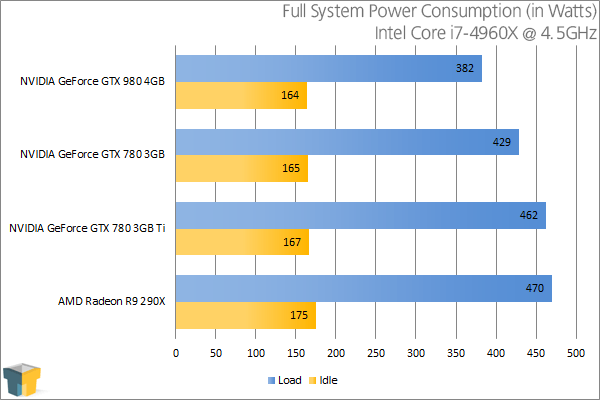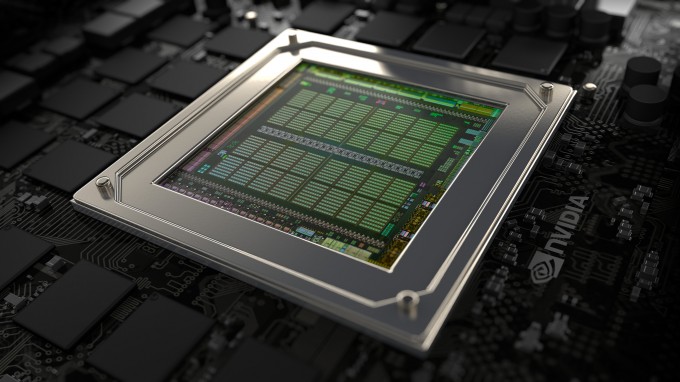- Qualcomm Launches Snapdragon 4 Gen 2 Mobile Platform
- AMD Launches Ryzen PRO 7000 Series Mobile & Desktop Platform
- Intel Launches Sleek Single-Slot Arc Pro A60 Workstation Graphics Card
- NVIDIA Announces Latest Ada Lovelace Additions: GeForce RTX 4060 Ti & RTX 4060
- Maxon Redshift With AMD Radeon GPU Rendering Support Now Available
NVIDIA GeForce GTX 980 Review: Does Maxwell Bring Maximum Gameplay?

NVIDIA’s next-gen GeForce series is here, and it brings with it a slew of new features and enhancements worth knowing about. Based on Maxwell, the GTX 900 series delivers much-improved performance-per-watt, with the GTX 980 in particular performing better than the 780 Ti – but with a TDP of 85W less. You read that right. Let’s dig in.
Page 11 – Power & Temperatures, Final Thoughts
To test graphics cards for both their power consumption and temperature at load, we utilize a couple of different tools. On the hardware side, we use a trusty Kill-a-Watt power monitor which our GPU test machine plugs into directly. For software, we use Futuremark’s 3DMark to stress-test the card, and AIDA64 to monitor and record the temperatures.
To test, the general area around the chassis is checked with a temperature gun, with the average temperature recorded. Once that’s established, the PC is turned on and left to site idle for ten minutes. At this point, we open AIDA64 along with 3DMark. We then kick-off a full suite run, and pay attention to the Kill-a-Watt when the test reaches its most intensive interval (GT 1) to get the load wattage.


Like the GTX 780 and 780 Ti, the GTX 980 has a temperature cap of 80°C (don’t ask me how the Ti broke past that), though compared to those cards, it idled a bit higher. What’s really impressive here is the improvements with the power draw – the GTX 980 drew 80W less than the 780 Ti – yet it’s the faster card of the two.
Final Thoughts
When any GPU vendor releases a brand-new series that’s more powerful, more power-efficient, and has more features, that alone shouldn’t be enough to “wow” us – that’s progression, and we’ve seen similar examples of it time and time again. But Maxwell is a bit different. I find myself being more impressed than usual, and I have a handful of reasons to quantify it.
Let’s start at the top: The GTX 980 is the fastest graphics card (not counting the duals) that NVIDIA’s ever produced. It’s even faster than the $999 TITAN Black, but costs $450 less. Of course, TITAN Black still has an even larger framebuffer, and also high double precision performance, but for the normal gaming enthusiast, neither of those perks will matter.

(Click image for a wallpaper version)
When the 780 Ti launched last year, it retailed for $649. The GTX 980 today, by contrast, is at least 10% faster, and retails for $549. Granted, I kind of wish it retailed for $499, as I believe the card would have really flown off the shelves, but it’s not just the performance boost that matters here. The GTX 980 shaves 85W off of the 780 Ti / TITAN Black’s TDP. As our above results show, that’s not just “on paper” – we saw a difference of 80W between the 980 and 780 Ti in our testing.
Until a couple of generations ago, I didn’t even realize that I cared about power efficiency. When things really struck me was with the launch of the GTX 750 Ti. At the time, and even today, I am surprised at the amount of performance that a modest card without a power connector can muster. So when I look at the 980 and see a card that’s faster than the previous flagship, yet requires 80W less power, I’m seriously impressed.
On top of all that, Maxwell brings a number of cool enhancements, including multi-frame sampled AA, memory compression, dynamic super resolution (one feature I’m looking forward to using in particular), as well as the seriously robust lighting system VXGI.
With the GTX 980 featuring some 2,000 cores and a 165W TDP, it goes without saying that we’re going to see some truly high-end cards coming from NVIDIA before the 900 generation is through.
Pros
- The GTX 980 is faster than a TITAN Black, but costs $450 less (SRP: $549 USD).
- Both the 980 and 970 have 4GB framebuffers, and can utilize color compression.
- High performance-per-watt rating; GTX 980 shaves 85W off of the 780 Ti’s TDP.
- Dynamic Super Resolution can improve game fidelity even on a 1080p screen.
- MFAA can give great AA results at lower performance cost.
- Some technologies will be backported to Kepler at some point in the future.
- Temperatures peak at 80°C; card doesn’t throttle when it hits that.
- Very overclockable (more on that later).
Cons
- A $499 SRP would have made the 980 fly off the shelves.

NVIDIA GeForce GTX 980
Support our efforts! With ad revenue at an all-time low for written websites, we're relying more than ever on reader support to help us continue putting so much effort into this type of content. You can support us by becoming a Patron, or by using our Amazon shopping affiliate links listed through our articles. Thanks for your support!





